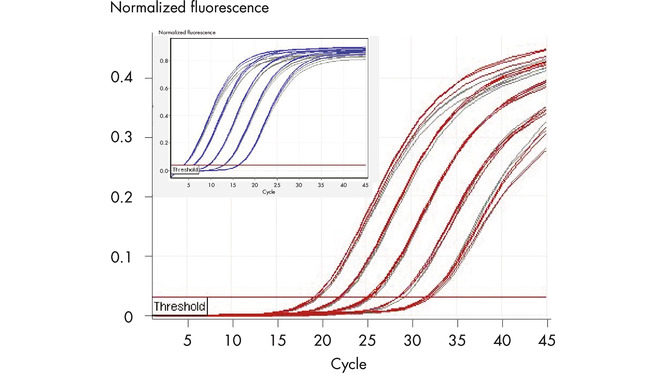Rotor-Gene Multiplex RT-PCR Kit
Rotor-Gene Q での1ステップの超高速マルチプレックスリアルタイム RT-PCR
Rotor-Gene Q での1ステップの超高速マルチプレックスリアルタイム RT-PCR
Rotor-Gene Multiplex RT-PCR KitはRotor-Gene Qでの使用を目的としてデザインされ、配列特異的プローブを用いた1ステップのマルチプレックスリアルタイムRT-PCRで特異性の高い定量を高速に実現します。サイクラーの搭載波長によっては、同一チューブ中で最高4種類までのRNAターゲット(例;コントロール遺伝子1つと3つの標的遺伝子)を同時に定量できます。特別に至適化されたマスターミックスとRotor-Gene Q の遠心エアコントロール方式の組み合わせにより、最高の性能を実現します。マスターミックスは2~8 ℃で保存でき、簡便に取り扱えます。
別々の反応ではなく同一反応内でコントロール遺伝子と標的遺伝子を増幅することで、マニュアルでの作業によるエラーが最小限に抑えられ、遺伝子定量の信頼性が高くなります。Rotor-Gene Multiplex RT-PCR Kit はRotor-Gene Q において信頼できるリアルタイムRT-PCR定量を実現します。反応条件やサイクリング条件の至適化は不要です(フローチャート " QIAGEN multiplex kits")。逆転写とPCRを同じ反応容器内で順次行なうことができ、1ステップのリアルタイムRT-PCRが可能です。逆転写反応の完了した反応液を他のPCR用チューブに移し替える必要がないのでリアルタイムRT-PCR操作を効率的に行なえ、ハイスループット解析が可能です。
K+ イオンとNH4+ イオンのバランスの取れた配合により、プライマーの特異的なアニーリングを促進するため、高感度で特異性の高い増幅が確実にできます。また、画期的なPCR添加剤である合成Factor MPは、難しいマルチプレックスPCRアプリケーション用に特別に開発されたもので、様々なアンプリコンを同一の反応で同様に高い効率で増幅できるようにします(図 " ユニークなPCRバッファー")。
画期的なPCR 添加物であるQ-Bond により性能を損なうことなく高速サイクリングが行なえ、サイクラーのランニング時間は大幅に短縮されます(図 " プライマーの高速なアニーリング")。さらに最適化された逆転写酵素ミックスによりわずか15分で効率的なcDNAを行なう一方、厳密性の高いホットスタート酵素HotStarTaq Plus DNA PolymeraseはPCR 開始時の95℃、5分の短いインキュベーションで迅速に活性化されます。
| 構成 | 特徴 | 利点 |
|---|---|---|
| HotStarTaq Plus DNA Polymerase | 95ºC、5分で活性化 | 室温で定量PCR反応のセットアップ |
| Rotor-Gene Multiplex RT-PCR Buffer | バランスの取れたNH4+ イオンおよび K+ イオンの配合 | プライマーの特異的アニーリングにより信頼できるPCR結果を実現 |
| 合成Factor MP | 4遺伝子まで同一チューブで信頼できるマルチプレックス解析が可能 | |
| ユニークな Q-Bond 添加剤 | PCR時間が短縮し、迅速に結果を得られ、1日あたりの反応数を増やせる | |
| Rotor-Gene RT Mix | RNAに対して高い親和性を有する逆転写酵素を特別に配合 | 複雑な二次構造を取る場合でも、わずか15分でRNAを逆転写可能 |
即使用可能なマスターミックスにより、プライマーやプローブ濃度などの反応条件やサイクリング条件の至適化が不要です。RNAテンプレート、プライマープローブセット、添付の逆転写酵素ミックスをマスターミックスに添加し、サイクラーをプログラミングします。製品のハンドブックには、推奨の色素リストやマルチプレックスRT-PCR 用の1種類のプロトコールなど、必要な情報が記載されています。
Rotor-Gene Multiplex RT-PCR Kitは、Rotor-Gene Q上で配列特異的プローブを用いて迅速な1ステップリアルタイムRT-PCR解析を行なうのに最適化されています。本キットは、Rotor-Gene 3000 およびRotor-Gene 6000にも適合します。最高4種類までのRNAターゲットを同一チューブ内で迅速かつ同時に定量できるため、処理数を増大し貴重なサンプルも節約できます。

| Features | Specifications |
|---|---|
| Applications | |
| Real-time or endpoint | |
| Single or multiplex | |
| With or without ROX | |
| SYBR Green I or sequence-specific probes | |
| Reaction type | |
| Sample/target type | |
| Thermal cycler |